Joshua Tree and Salton Sea
It was still raining and snowing when we left Hole in the Wall camp (Mojave Preserve). The vast southeastern corner of the reserve is visible coming down from camp, and it was a pretty sight indeed.

We were grateful for Howie’s warmth as we drove the roads and highways across the desert, gradually descending into Amboy. This town was in its heyday when Route 66 was the only byway. Of course, Interstate 40 put it nearly off the map. Roy’s Café has been hanging in there over the years, and we noted some new paint and spiffier digs for tourists. Maybe the nostalgia generation is upon us? It is for me, and I can never pass by here without taking a picture of the Route 66 logo painted on the highway.
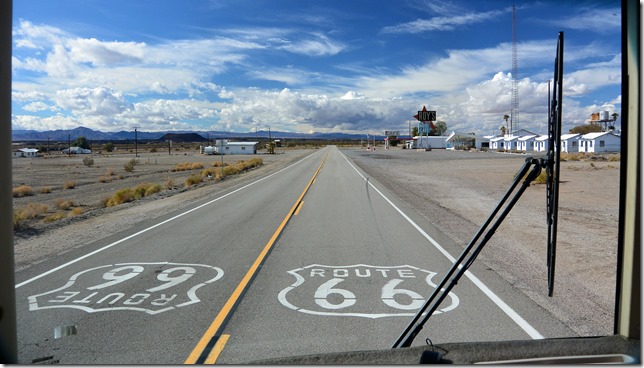
Just beyond the town is the Crater of the same name. This is simply an implausible sight, sitting in the middle of the desert. No matter how much we read, and how sincerely and certainly we know of the volcanic origins of many of the hills and ridges, nothing brings it home with more assurance than a big, black/brown cinder cone. This alone is worth hopping OFF the interstate for a nice drive by. Treat yourself to some of Ray’s $5/gallon gas, if you feel like making a donation. Or, just fill up before you exit I-40.
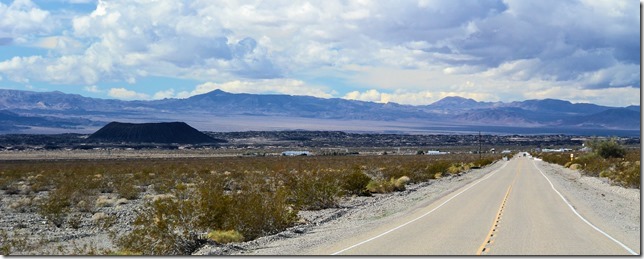
Ever southward, we trekked over the hill below Amboy, passing by more lonely highway and more vast desert expanses. We never get tired of this huge space, and today’s gorgeous light and sky makes it as special as ever.
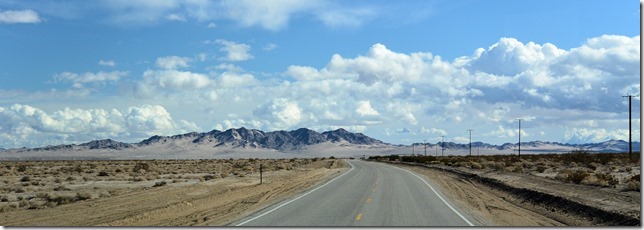
We drove into Twenty-nine Palms just as another big rainstorm hit. But at least it was 56F instead of 38F. We picked up some groceries and gas, and since it was late in the day, decided to overnight at Joshua Tree NP. We’ve been there several times, and it’s always a nice drive to cut through the park (no commercial vehicles please) instead of going far around the east or west ends.
We avoided the popular, crowded, 124-site camp at Jumbo Rocks, and chose instead a pleasant site (#5) in the much cozier 18-site Belle campground. The scenery is just as great, and there are fewer crowds. Think Nature Walk instead of Disneyland.
At 4PM, with only a half-hour of light left in the day, we unhooked Ralph and made a quick sortie up to one of the more famous attractions in the park, Skull Rock. It’s just a rock with some weathered cavities in it, but you can’t deny that it looks hauntingly like a human skull. Here are a couple of shots from different angles:
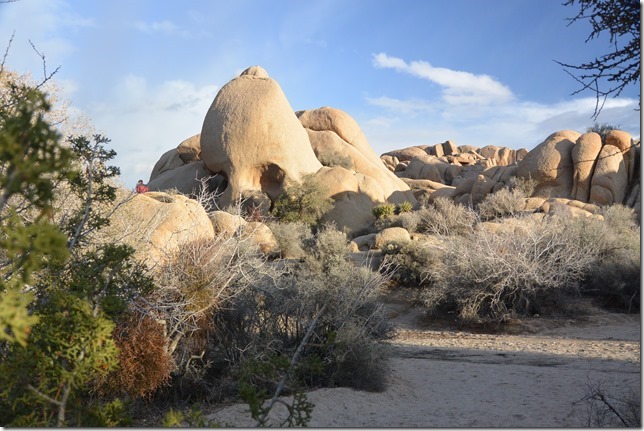
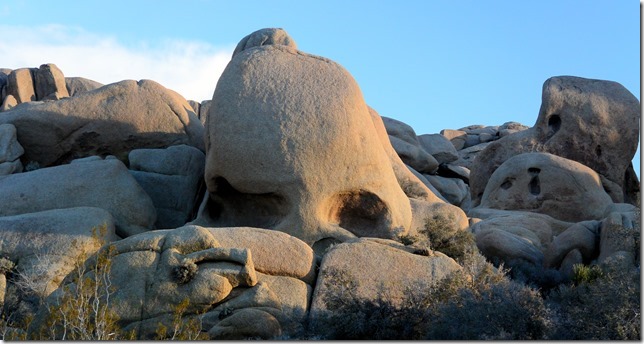
Surrounding the Skull are many, many formations of the characteristic rocks in this area. The evening light made for some nice shadowing, and the after-the-storm sky was a beautiful backdrop.
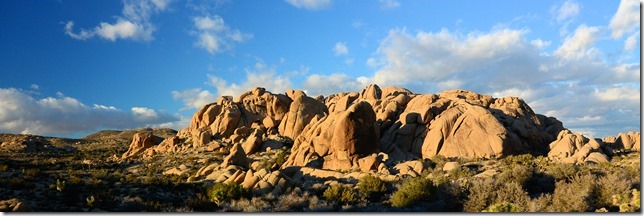
These rock formations are created in an interesting fashion, wonderfully illustrated by the Park newspaper. Here is a “picture of a picture” showing the growth process that creates these giant clusters of boulders.
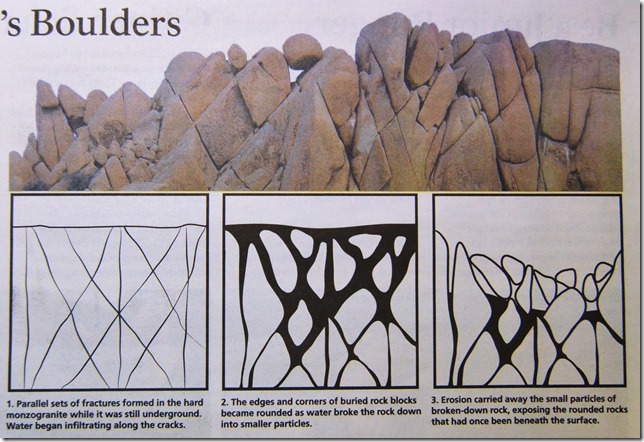
Friday morning dawned clear but cold, with a brisk wind to help the bone-chilling process. Our campsite in Joshua Tree NP was quiet, private, and beautiful. However, we were in “traveling mode”, so we pulled out of camp, headed for lower and warmer digs. But we had 30 miles of Park to traverse, and there were yet some sights to see.
First stop was the Cholla Forest, over a thousand acres of these pernicious little plants. This particular variety is called the “Teddy Bear” cholla, said to be due to it’s “cuddly” appearance, but more likely just to confuse and distract the unwary.
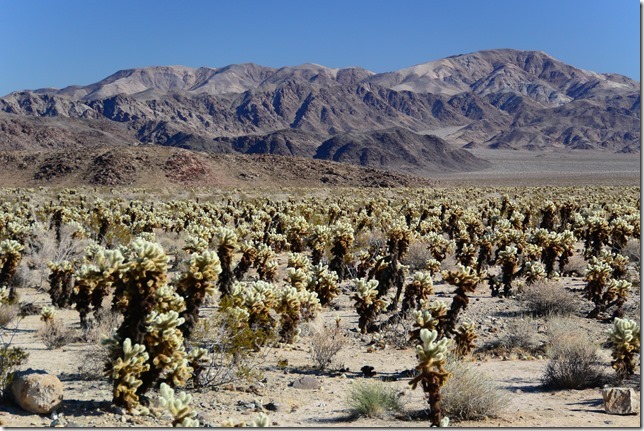
All cholla’s, and particularly the Teddy Bear, have a proliferate spine system, with each spine covered in microscopic back-pointing barbs. Once in, they don’t come out. Not from clothing, skin, boots, tires, or dog lips. Worse, they’ll actually work their way deeper.
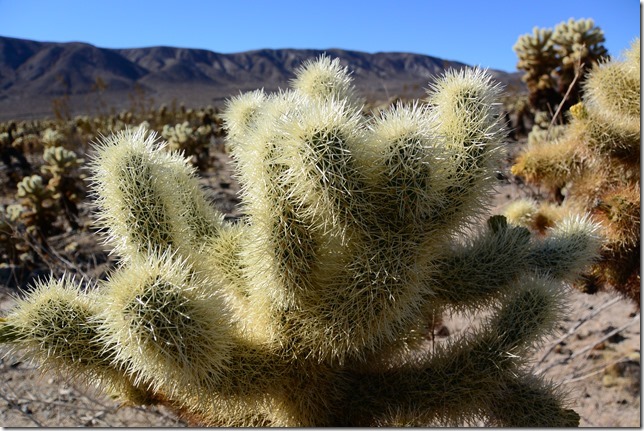
As if that’s not enough, these dastardly spawns of Satan also break off little pieces of themselves as part of their primary propagation scheme. The pieces roll across the ground with wind and water, and will literally root themselves to new ground at any opportunity.
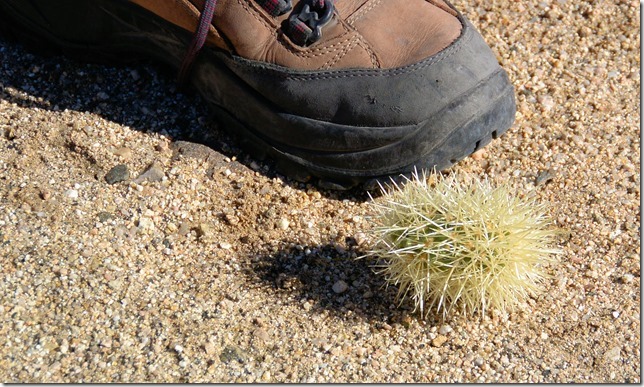
Cholla, and other desert plants, are extremely frugal with their water and nutrition. Branches are hollow and perforated, creating no more wood than necessary to sustain the plant.
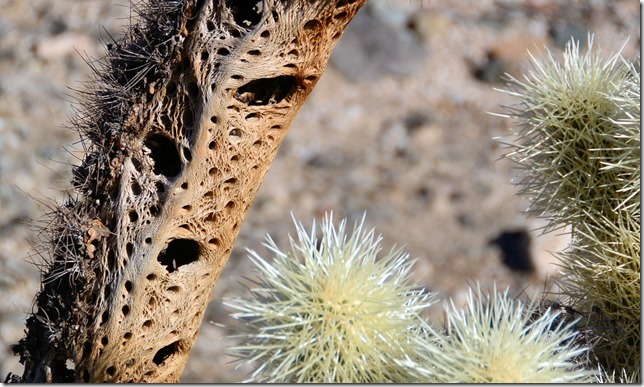
Both the Cactus Wren and the Wood Rat actually make use of the infernal flora, nesting and burrowing right through the insanely sharp, barbed spines. This massive nest, twelve feet across, was made by wood rats. The nests are continuously “enhanced”, and taken over by new rats as the old ones leave, die off, or get eaten. These hand-me-down nests have been dated back to 10,000 years’ of age, by examining their inner contents of ancient plant material.
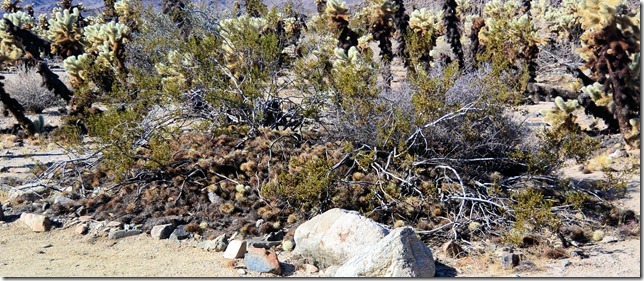
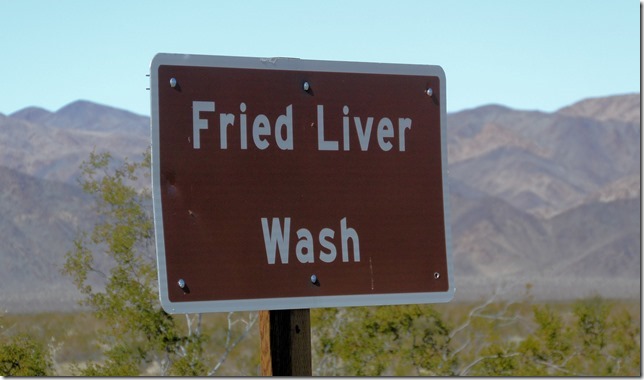
Traveling the desert gets one accustomed to names like “Cottonwood Creek”, “Rattlesnake Gulch”, “Piute Ridge”, and such obvious derivations. But occasionally, a truly enigmatic appellation arises. Like this one. No, I have no idea how it came to be.
Another enigma. Out in the middle of a vast alluvial plain, sits this pile of rocks and boulders. People did NOT put it there. Again, I have no idea of its origin. Any geologists reading this care to weigh in?
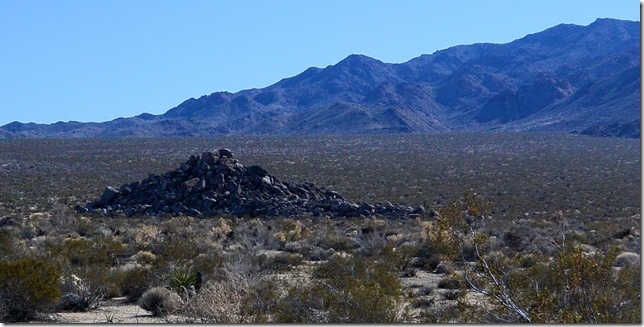
Up the rising plain, then across the hidden Coachella Valley, sit the 12,000-foot peaks of the Jacinto Mountains above Palm Springs. Nice clear day (finally) to see the new mantle of snow.
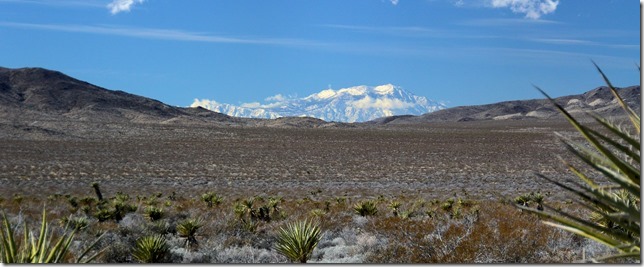
Different shot – – – same mountains, much later in the day, after we crossed the Imperial Valley to the northeast shore of Salton Sea.
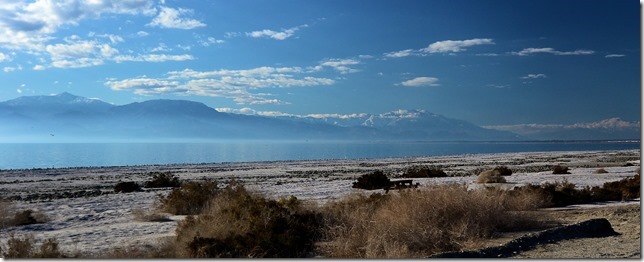
Salton Sea is an amazing place, with an improbable tale of its genesis. Short story is that early irrigation efforts, using Colorado River water, got out of hand. In 1905, the river busted loose through a crappy canal system, and it was sixteen months before it could be re-directed back to its old course. During that time, the entire flow of the mighty Colorado was poured straight into the second lowest spot in the entire U.S. (And it was a LOT of water back then, well before all the dams and diversions that later decimated the river.) This massive screw-up created the lake/sea that persists today, 20 by 45 miles of it. And, since the area was originally an inland sea (and had historical salt mining operations on-going), the old salt deposits made the new Sea a salty one.
Today, Salton Sea is even saltier – – it gets replenished by agricultural runoff, essentially fresh water with a bunch of fertilizer and plant nutrients dissolved in it. Meanwhile, the desert evaporation sucks millions of gallons of water out of the lake, and all the minerals and such remain in solution. What happens after a hundred years of such off-balance ecological nonsense? The nutrient-rich waters host algae and bacteria, which flourish – – and use up all the oxygen. Then the animal life (invertebrates and fish) die off. With the inflow slightly less than evaporation, the Sea shrinks a bit each year. Result – – the shoreline is a dense blanket of dead invertebrate shells and dead fish skeletons (the white mounds) interwoven with the silt and mud (darker areas). [Howie is way off to the upper left.]
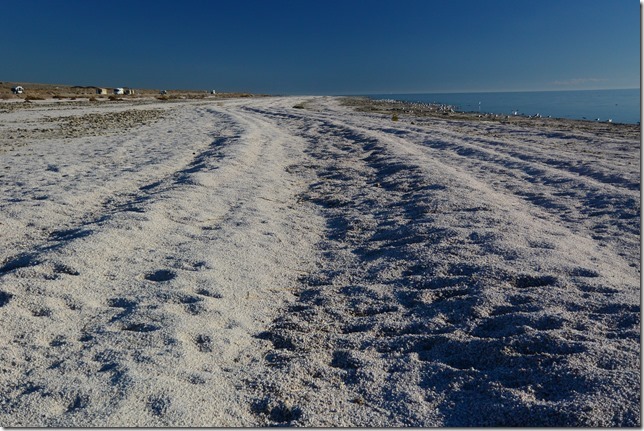
The “grains” of the shell/sand are very large and light, composed of dead barnacles and pieces of fish skeletons like the tiny vertebra Karin is pointing to. Millions of tons of this stuff line the shore.
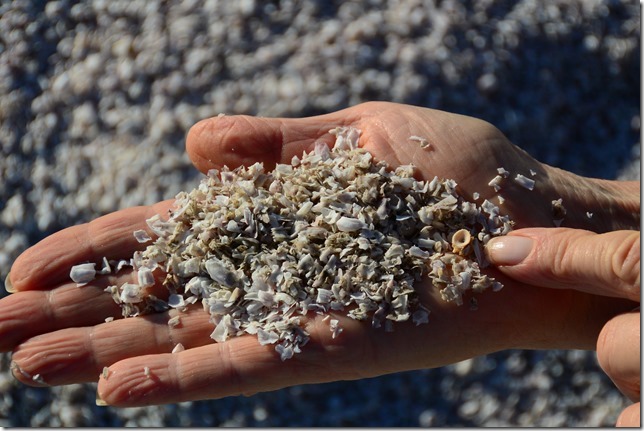
Spicing up the visual (and olfactory) delights is an extensive sprinkling of fish skeletons, full and partial. Yes, we’re told that sometimes it stinks a bit. Not here today though.
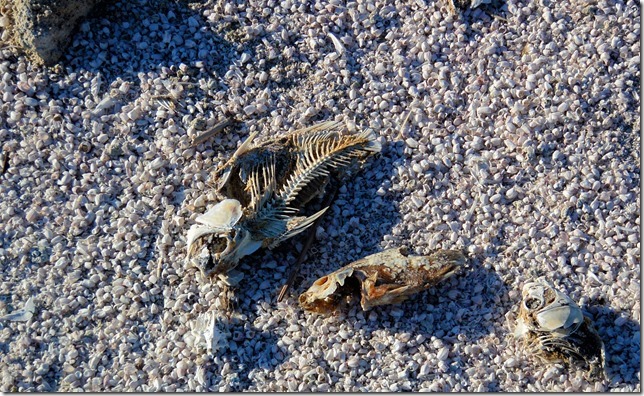
Despite its dim history, the Sea is today a haven for waterfowl, and we watched gulls, pelicans, herons, and a host of lesser birds find their resting places for the approaching night. Seeing their low gliding flights across the water, silhouetted against the setting sun, was a sublime experience. This shoreline is (at least in its unpopulated areas) a pretty pleasant place to spend an evening. Which is exactly what we are doing.
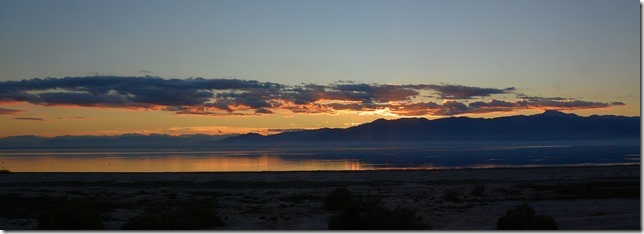
We camped at Corvina, the least popular campsite in this area. No water, no hookups, no entertainment. Ten bucks a night. They call it “primitive”, but it has great showers and restrooms, pretty elegant compared to some of the nowhere places we’ve been. We met an Irish family (of four) in a VW expedition vehicle. They’re two years into a roaming lifestyle, working on the road via Internet and traveling wherever their whims and visas take them. Lots less room than we have in Howie, but they’re having a grand time. Meeting and chatting with folks like this is one of the greater joys of wandering the country in an RV.
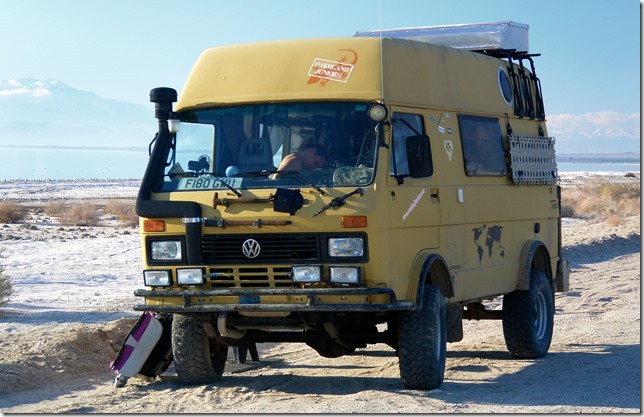
Tomorrow we’ll head out, working our way towards Quartzsite (for the RV show). Not sure where we’ll stay or what we’ll be doing, since Quartzsite is still a week away. Stay tuned.

Hi Greg, Once again you are reviving our wonderful memories of USA, especially Joshua Trees NP which we loved. So grateful for all the tidbits of info which we would otherwise not know. Thanks.
Elizabeth, I’m always surprised and pleased to see how much of this country you’ve explored. I hope you’re not so bored with it that we never see you back again. Will we be in Australia before you hit the USA again? Who knows…
Very good reporting sir! Wishing you a very blest New Year!